Speaking of transport, we present the image of a car, trolley bus, bus or some other vehicle, but the bicycle, as a rule, is not taken seriously by us. Quite often on the roads you can find cyclists clinging to the curbs for their safety. The article will discuss whether the bicycle is considered a means of transport, and if so, what type it belongs to.
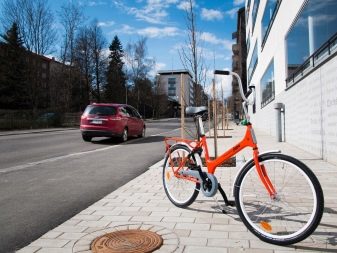
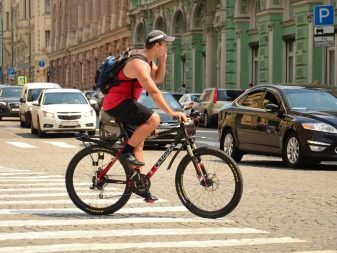
Vehicle Definition
According to the definition of the SDA, transport means devices for transporting people, as well as cargo and equipment installed in transport. This is indicated in paragraph 1.2 of the code of practice. That is, the main function of the vehicle is transportation. Classification involves several types:
- rail;
- wheeled;
- crawler.
According to the rules of the road, a bicycle is also a mechanical wheeled vehicle, driven by the muscles of a person sitting on it, or by an electric motor having a maximum power during continuous movement not exceeding 0.25 kW and turning off at speeds above 25 km / h

A cyclist is considered a bicycle driver, he is obliged to comply with the rules of the road and be responsible for their non-compliance and for traffic safety. This is especially true for those cyclists who ride on the highway.
Having left on the carriageway, the cyclist becomes a full-fledged participant in the road as well as the driver of cars or public transport. However, not all bike riders are conscious, even though they are already quite old. The motorway can only be reached by people who have reached the age of 14. Very often, cyclists and older people behave like pedestrians on the road.
It should always be remembered that when dismounting from a bicycle, a person obeys the general rules for pedestrians, and while moving on a bicycle - obeys the rules for car drivers.
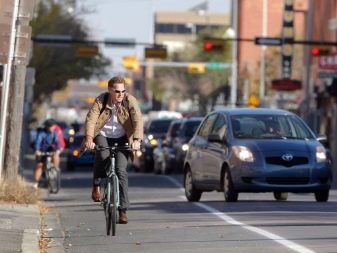
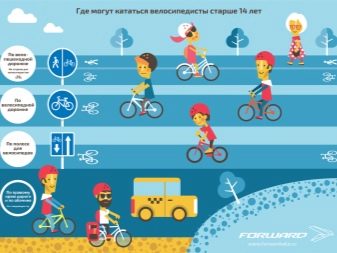
Cyclist Responsibilities
A cyclist must equip his bike with headlights. Front mounted white, red behind, like a car. Equip the wheels at the rear, front and sides with reflectors so that in the dark other drivers understand who is driving in front. And also the bicycle must have a steering wheel, brake system and sound signal in perfect condition. For the carriage of passengers there must be a special seat attached to the trunk or frame. This applies to the transportation of preschool children.
The cyclist is obliged to carry out his movement on the highway in the far right lane if a bicycle path is not provided for in this section. If it is, then it is allowed to move only on it. On the highway, the cyclist moves in the same direction as other vehicles, and not towards them.
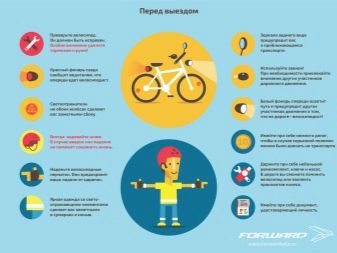
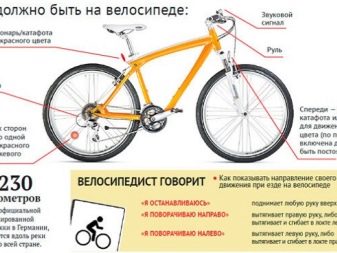
Bicycle columns are required to move in one row, the maximum number is 10 people. If the group of athletes is larger, it is necessary to divide into 2, 3 or more columns, depending on the number of cyclists. The distance between the columns should be at least 80 meters for sufficient space for maneuvering cars.
The bike has no turn signals, but nonetheless the person driving this transport is obliged to give signals indicating his intentions. If he wants to make a left turn, that means he shows it with his left arm extended to that side, and if it is to the right, then his right. When the cyclist wants to stop, he must extend one arm high up.
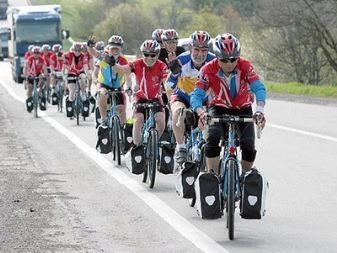
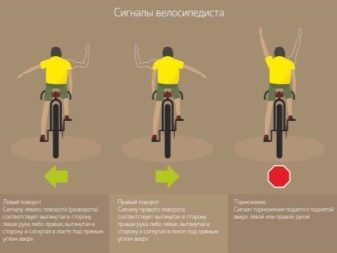
Cyclists are allowed to move along the sidewalks only if they are transporting a passenger of preschool age or those who are escorting a convoy of schoolchildren. If the cyclist interferes with the movement of pedestrians, then he must continue on his way, dismounting to the ground, like a pedestrian. Once again, he will be able to get behind the wheel of a bicycle in freer sections of the path.
Must move following the directions of the road signs specially designed for cyclists, and also follow the requirements of road signs, which are provided for any participant in the movement. At unregulated pedestrian crossings, a cyclist passes pedestrians in the same way as if he was driving a car.
To cross the intersection, the cyclist must make a reference to the special signal of the “bicycle” traffic light. If there is none, then there is a reference to the general.

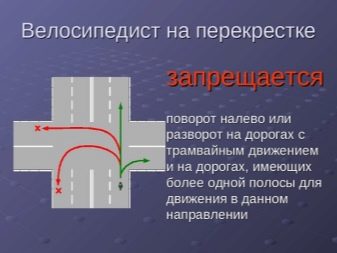
Prohibitions and Offenses
Along with obligations, there are also prohibitions, which are provided for in paragraph 24.8 of the SDA. It lists what is strictly forbidden to the cyclist.
- Release the bike handlebar while driving anywhere. This applies to freeways, sidewalks and special bike paths.
- Transportation of cargo that does not comply with the permissible standards in size. The cargo should not protrude on either side for more than half a meter.
- Carriage of passengers on a bicycle that does not have special equipment.
- Getting around on a pedestrian crossing. It is necessary to dismount.
- To move without a special helmet or with unfastened clamps.
- Turn or turn left along tram lines and along a road where several lanes are indicated.
- Do not tow anything other than trailers.
- Drive while intoxicated.
- Drive after taking stupefying or potent drugs.
- Take the freeway if there is a bike path nearby.
- Drive along roadsides or dividing lanes.
- Transfer the bike to another person who has traveled long distances while intoxicated, under the influence of drugs or taking potent drugs.
- Talk on the phone without a headset while driving.
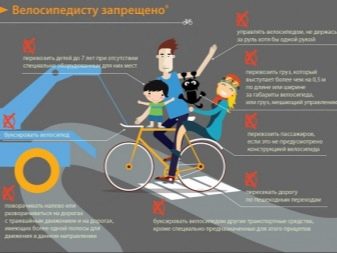
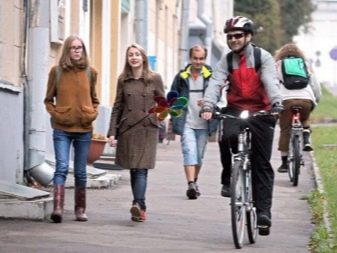
Traffic police fines
Since the person driving the bike is the driver of the vehicle, especially if driving on the road, fines and penalties are provided for violation of the rules and laws. The Code of the Russian Federation on Administrative Offenses (CAO) states what the fine is specifically for.
So:
- any offense by a cyclist is fined in the amount of 800 rubles;
- if the rule is violated while intoxicated, then the fine is already from 900 to 1600 rubles;
- when creating obstacles to the movement of vehicles, a fine of 800 rubles is charged;
- in case of harm to human health - a fine of 900 to 2,000 rubles, depending on the severity of the damage.

Traffic signs for a bicycle driver
There are three main bicycle signs, of which two are prescriptive and one prohibitory:
- “The intersection of a bicycle path with a pedestrian” and others is a prescriptive sign;
- the sign “bicycle path” is also prescriptive;
- the sign "forbidden to ride a bicycle" - prohibiting.
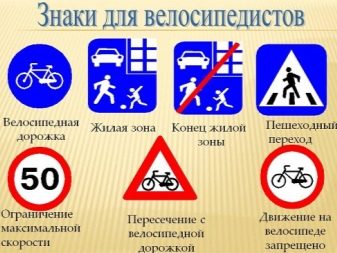
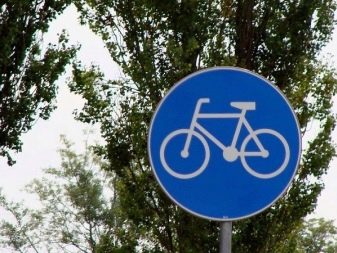
And there are also common signs that a cyclist needs to take into account, such as:
- "Movement Prohibition";
- "road up";
- “Road only for cars”;
- “Pedestrian zone” or “pedestrian path”.
Given all the rules and regulations for cyclists, you can enjoy riding, combining business with pleasure.
Riding a bicycle is not only an environmentally friendly way of transportation, but also training in physical qualities.
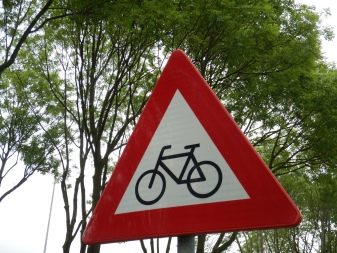
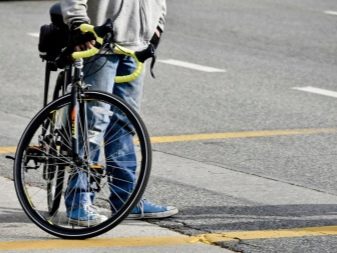
In the next video, traffic rules for cyclists await you.










